-
United States -
United Kingdom -
India -
France -
Deutschland -
Italia -
日本 -
대한민국 -
中国 -
台灣
-
Ansys는 학생들에게 시뮬레이션 엔지니어링 소프트웨어를 무료로 제공함으로써 오늘날의 학생들의 성장을 지속적으로 지원하고 있습니다.
-
Ansys는 학생들에게 시뮬레이션 엔지니어링 소프트웨어를 무료로 제공함으로써 오늘날의 학생들의 성장을 지속적으로 지원하고 있습니다.
-
Ansys는 학생들에게 시뮬레이션 엔지니어링 소프트웨어를 무료로 제공함으로써 오늘날의 학생들의 성장을 지속적으로 지원하고 있습니다.
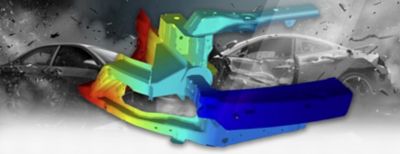
안전한 차량을 설계하는 것은 단순히 우수한 운영이나 규제 요구 사항때문만은 아닙니다. 자동차 산업에 있어 안전은 도덕적 필수 요소입니다. 사고는 발생할 것입니다. 그렇게 되면 차량 설계는 운전자, 승객, 보행자의 삶과 죽음을 가를 수 있습니다. 더 안전한 설계는 자동차 충돌 사고로 인한 개인, 의료 시스템 및 사회에 미치는 경제적 부담을 완화합니다.
본질적으로 안전한 설계는 모든 차량을 가능한 한 안전하게 만들 수 있는 업계의 능력에 많은 영향을 받습니다.
이상적으로는 "어떤 비용을 치르더라도 안전이 최우선"이지만, 자동차 엔지니어들은 주로 개발 일정 단축과 예산 제한이라는 상충되는 압박에 직면하고 있습니다. 결과적으로 엔지니어는 사고 심각도를 줄이기 위해 안전 측면을 우선시하거나 안전 기능의 단계적 구현과 같은 보다 비용 친화적인 전략을 모색해야 할 수 있습니다.
CAE(Computer-Aided Engineering)는 안전과 출시 시간의 균형을 맞추기 위해 차량 설계 프로세스에서 필수적인 부분이 되었습니다. 가상 해석을 통해 설계자는 차량의 충돌 및 안전 성능을 안정적으로 평가하는 동시에 비용이 많이 드는 물리적 테스트를 줄일 수 있습니다.
Ansys 애플리케이션 엔지니어들은 최근 Ansys SimAI 클라우드 지원 생성형 인공 지능(AI) 플랫폼을 사용하여 자동차가 고속으로 전면 충돌 시 자동차 범퍼가 어떻게 변형될지 빠르게 예측했습니다.
이러한 노력은 특히 전산 유체 역학(CFD) 솔버로 시뮬레이션된 일정한 운동에서 유체의 이동 방식을 예측하는 데 효과적인 것으로 입증된 이 소프트웨어가 비선형 과도 구조 시뮬레이션과 같은 다른 물리학도 처리할 수 있음을 보여주었습니다.
정확도 및 속도
차량이 점점 더 복잡해짐에 따라 설계에 사용되는 디지털 모델도 복잡해지고 있습니다. 모델도 그 어느 때보다 커지면서 더 많은 컴퓨팅 리소스와 훨씬 긴 시뮬레이션 시간이 필요합니다.
오늘날 4,000만~5,000만 개의 요소가 있는 전체 차량 모델을 보는 것은 드문 일이 아닙니다. 700~1,000개의 CPU로 구성된 최신 고성능 컴퓨팅 클러스터에서 전체 충돌 이벤트를 해결하는 데 25~30시간이 걸립니다. 이는 엔지니어가 새로운 CAD(Computer-Aided Design)을 수정(기존 프로그램에서 부품과 하위 시스템을 재사용한 후에도 남아 있는 교차점과 틈새 제거하는 작업과 같이 초기 설계 단계에서 흔히 발생하는 작업)하고, 격자를 생성하고, 필요한 모든 연결점과 재료를 추가하고, 오류를 디버깅하고, 기준이 되는 성능을 설정하는 등의 수개월 동안의 노력에 더해지는 시간입니다.
엔지니어가 설계 변수를 명확하게 정의하고 변경되는 모델의 주요 측면마다 파라미터를 생성하지 않는 한 CAE 모델은 모든 설계 변경 사항을 따라가지 못하는 경우가 많습니다. 특히 복잡한 설계 변경의 경우 파라미터화는 까다롭고 시간이 많이 걸리므로 철저하게 평가되는 설계는 극히 일부에 불과합니다.
바로 여기서 SimAI 플랫폼의 강력한 힘이 발휘됩니다.
SimAI 제품은 Ansys 시뮬레이션의 예측 정확도와 생성형 AI의 속도를 결합하여 몇 분 내에 새로운 설계에 대한 전체 3D 응답을 예측할 수 있습니다. 복잡하고 계산량이 많은 프로젝트의 경우 유한 요소 솔버보다 10배~100배 더 빠르게 출력을 예측할 수 있습니다.
시뮬레이션 프로세스의 속도를 높이면 더 많은 설계 탐색이 가능하므로 자동차 엔지니어가 추가 아이디어와 혁신을 시도하고 프로세스 초기에 유망한 설계에 집중할 수 있습니다.
모델 훈련
SimAI 기술은 물리학에 구애받지 않는 클라우드 기반 소프트웨어로, 유체, 구조, 전자기 등을 다루도록 AI 모델을 훈련할 수 있습니다.
모든 것이 빠르게 끊임없이 변화하는 자동차 충돌과 같은 과도 이벤트를 예측하는 방법을 보여주기 위해 Ansys 애플리케이션 엔지니어는 간소화된 Ansys LS-DYNA 구조 시뮬레이션 소프트웨어 차량 모델인 "Sled"로 시작했습니다. 이 경우 Sled는 초당 15.6m(16.4야드)의 속도로 강체 벽에 충돌하는 범퍼를 시뮬레이션했습니다.
Ansys 엔지니어는 과도 응답을 정확하게 예측할 수 있는 충분한 데이터 포인트를 생성하기 위해 설계 변형을 도입했습니다. 최소 및 최대 경계 내에서 7개 부품의 두께를 변경하여 총 2,058개의 훈련 데이터 포인트에서 각각 찌그러짐, 구부러짐, 접힘 등 21개 상태로 98가지 설계가 생성되었습니다.
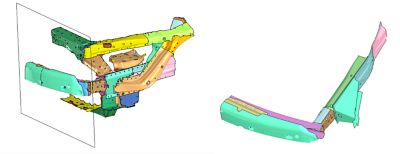
범퍼 충돌 모델. 강조 표시된 부품의 부품 두께에 변동을 부여함.
그런 다음 데이터를 SimAI 플랫폼에 업로드했고, 여기서 훈련 데이터는 훈련, 검증 및 테스트 세트로 자동 분할되었습니다. 검증 세트를 통해 모델의 기본 구조를 조정하여 성능을 개선할 수 있었고, 테스트 세트를 통해는 모델이 익숙하지 않은 상황을 얼마나 잘 처리할 수 있는지 확인했습니다.
그 다음에 모델을 구성했습니다. 여기에는 다음을 결정하는 것이 포함됩니다.
- 경계(또는 충돌) 조건.
- 입력 - 이 경우 충돌 중 서로 다른 시점과 여러 부품의 두께.
- 출력 - 강체 벽의 힘(또는 벽에 가해지는 힘의 양) 및 절점 변위(범퍼에 표시된 점이 위, 아래, 왼쪽 또는 오른쪽으로 이동하는 거리).
- 모델을 훈련하는 데 필요한 시간에 직접적인 영향을 미치는 정밀도 수준. “정밀한” 모델은 훈련에 최대 2일이 걸리지만 “매우 정밀한” 모델은 일반적으로 일주일이 소요됨. 이 경우 모델은 훈련하는 데 약 21시간이 걸렸습니다.
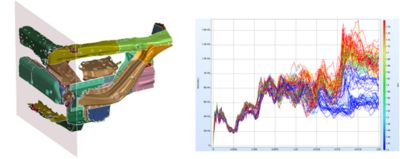
범퍼 변형 상태 및 강체 벽 시간 기록 플롯
Ansys 엔지니어는 충돌 시 벽에 가해지는 힘을 기존 솔버의 결과와 비교하여 SimAI 소프트웨어의 정확도를 평가했습니다.
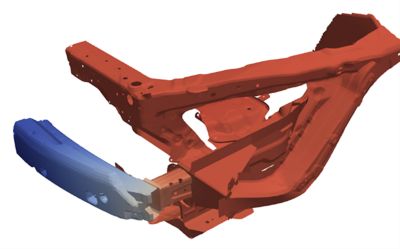
노드에 변위 필드가 있는 샘플 vtp 파일. 지오메트리는 vtp 또는 vtu 파일 형식으로 작성됨. vtp는 표면(쉘 요소) 데이터를, vtu는 볼륨(솔리드 요소) 데이터를 보관.
결과 확인
솔버와 SimAI 제품이 수행한 예측을 플로팅하였을 때 약간의 차이가 나타났습니다. 둘 다 범퍼의 모양과 벽의 힘을 동일한 시점에 예측했지만 모든 지점이 완벽하게 일치하지는 않았습니다. AI의 예측점은 솔버와 정확히 동일한 지점(그래프에서 대각선 라인)에 도달하지 않았습니다.
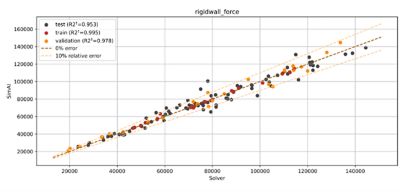
글로벌 계수 rigidwall_force에 대한 Ansys SimAI 클라우드 지원 생성형 인공 지능(AI) 플랫폼 추세 플롯
이것은 실제로 좋은 상황입니다.
완벽한 일치가 항상 최선의 결과는 아닙니다. 완벽한 일치는 AI가 훈련 데이터를 과대적합했다는 것을 의미할 수 있습니다. AI가 기본 규칙이 아닌 훈련받은 구체적인 예제만 기억했다는 것을 뜻합니다. 과대적합 AI는 이전에 보지 못했던 완전히 새로운 설계를 예측하는 데 능숙하지 않을 것입니다.
그러나 SimAI 소프트웨어 예측은 대부분 솔버의 예측과 제대로 일치하기 때문에 SimAI 모델이 과대적합 없이 정확했음을 시사합니다. 또한 플롯은 AI의 훈련이 더 나은 결과를 위해 개선될 수 있는 영역도 나타냈습니다.

솔버와 SimAI 플랫폼 간의 변형 형상 비교

솔버와 SimAI 플랫폼 간의 rigidwall_force 예측 비교
더 빠른 속도로 안전하게
결국 SimAI 기술은 기존 솔버보다 훨씬 빠른 것으로 입증되었습니다. 벽에 가해지는 힘을 1초 미만으로 예측하고 범퍼의 전체 움직임을 약 10초 만에 예측했습니다.
그러나 기존 시뮬레이션에 비해 유일한 장점은 속도만이 아닙니다. SimAI 솔루션은 충돌 시(훈련된 데이터의 한계 내에서) 모든 지점에서 어떤 일이 일어날지를 예측할 수 있기 때문에 결과뿐만 아니라 중간 상태를 포함하여 범퍼의 변형에 대한 보다 상세한 그림을 제공했습니다.
즉, 자동차 엔지니어가 비선형 과도 이벤트의 정확한 단일 모델을 보유하여 개발 예산에 대한 부담을 줄이면서 시장에 더 빠르게 출시할 수 있는 안전한 자동차를 만드는 것이 가능합니다.
"완전 과도 차량 충돌 결과를 예측하는 Ansys SimAI 소프트웨어" 백서 전문을 다운로드하여 SimAI 플랫폼에 대해 자세히 알아보십시오.
여러분을 위한 것입니다. 여러분이 확인해 볼 수 있는 몇 가지 추가 리소스가 있습니다.
자세한 내용
"완전 과도 차량 충돌 결과를 예측하는 Ansys SimAI 소프트웨어" 백서 전문을 다운로드하여 SimAI 플랫폼에 대해 자세히 알아보십시오.
Advantage 블로그
Ansys 및 기타 기술 전문가의 지식을 담은 Ansys Advantage 블로그에서는 인간의 발전을 이끄는 혁신을 뒷받침하고 있는 Ansys 시뮬레이션에 대한 최신 정보를 제공합니다.













